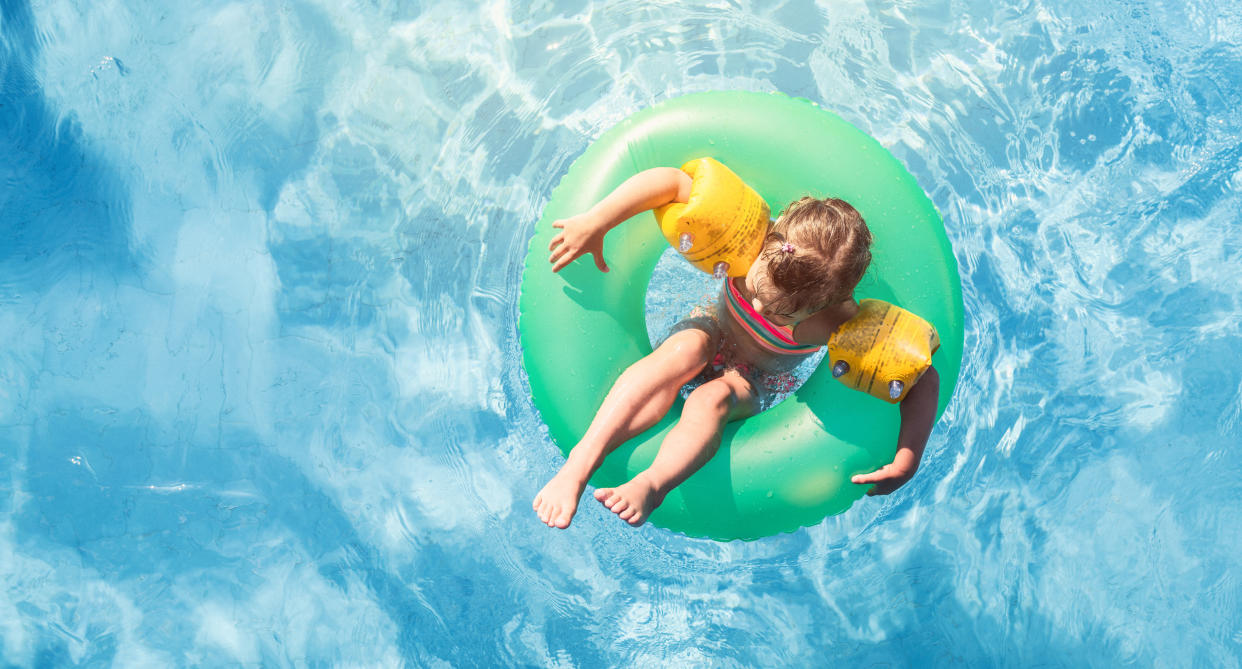After the drowning of Bode Miller's daughter, here's what everyone should know about pool safety

Olympic skier Bode Miller announced the tragic death of his daughter Emeline on Instagram Monday. The 19-month-old died in a drowning accident that occurred Sunday. “We are beyond devastated,” Miller wrote on Instagram. “Never in a million years did we think we would experience a pain like this.”
A post shared by Bode Miller (@millerbode) on Jun 11, 2018 at 4:07pm PDT
Emeline was the youngest of Miller’s four children and his second child with wife Morgan Beck Miller, a professional beach volleyball player.
According to TMZ, Miller and Beck Miller were attending a neighbor’s party and somehow, Emeline ended up in a pool. In the 911 call obtained by TMZ, a woman said Emeline had been in the water “a couple of minutes.” CPR was performed at the house before she was transferred to the hospital, but medical personnel were unable to resuscitate her.
Unfortunately, this is not an uncommon occurrence. In 2014, drowning was the second leading cause of unintentional death in children between ages 1 and 14 in the U.S. and among the 10 leading causes of death of children and young people in every region of the world, according to the World Health Organization.
In order to help combat this major issue, we spoke to nonprofit organization Safe Kids Worldwide about the most important tips for parents with children around pools.
To start, parents need to remember that kids are curious, so they will be drawn to the pool and anything interesting around it.
A four-sided fence should surround backyard pools so the entire pool is enclosed, urges Emily Samuel, senior program manager and swim expert at Safe Kids Worldwide. You also need a self-latching gate to provide an additional barrier. Clean up the pool area, not only so it looks nice but to keep kids at bay. “You want to make sure you remove any toys or things from inside or around the pool that may attract children to the water when no one’s around,” Samuel says.
“It’s essential that adults are supervising children when they are in or around water,” Samuel says. That doesn’t mean sitting idly by with a book; your eyes must be on them. You can still have pool parties. “We recommend that families choose a water watcher,” Samuel says. “So when there are several adults present, you should never assume that someone else is watching the children.” Choose one adult to be responsible for watching children near the water for certain periods of time (Samuel suggests 15 minutes), and then pass the responsibility to another parent. Safe Kids Worldwide even has a Water Watcher card that parents can download and print out to pass around so the designated watchers have a physical reminder of their responsibility.
You may think kiddie pools are safe because they are shallow, but that’s not the case. “Something that parents may not think about are kiddie pools,” Samuel points out. “A lot of parents have small kiddie pools in their yards for younger children. So you want to make sure those are empty and stored upside down when they’re not in use so they don’t collect water.”
Now, on to the actual swimming. This may seem obvious, but make sure your kids know how to swim before putting them in a pool. That doesn’t mean you have to get them to a swim class right away. “Every child is different, so you want to enroll children in swim lessons when they’re ready,” Samuel suggests. When deciding if it’s the right time, Samuel says to consider their age, their development, and how often they’re around water.
When they do start taking lessons, make sure they learn “water survival skills.” Children should be able to do five things in the water:
Step or jump into water over their heads and return to the surface.
Float or tread water for at least one minute.
Turn around in a full circle and find an exit out of the water.
Swim 25 yards to exit the water.
Exit the water; if they’re in a pool, exit the water without using a ladder.
Young children and weak swimmers should be within arm’s reach of an adult, and older children should always swim with a partner.
Accidents happen, but you can limit the risk by making sure you’re prepared. “Parents should know the most basic water rescue skills and CPR. It’s important for parents and caregivers to know how to respond in an emergency without putting themselves at risk of drowning,” Samuel says. She notes that the Red Cross has classes that teach basic water rescue skills as well as CPR.
In case of emergency, here’s what you need to know about drowning. Children can drown in less than a minute, according to Samuel. And when it happens, it might not be what you expect. “When children drown, some families might assume it’s similar to what you see on TV, so a lot of yelling and screaming and splashing around in the water, but drowning is actually very silent and it happens very quickly,” Samuel explains. “So that’s why it’s so important that you designate a water watcher and make sure you know what to look for and do in an emergency.”
Read more on Yahoo Lifestyle:
Follow us on Instagram, Facebook, and Twitter for nonstop inspiration delivered fresh to your feed, every day.

